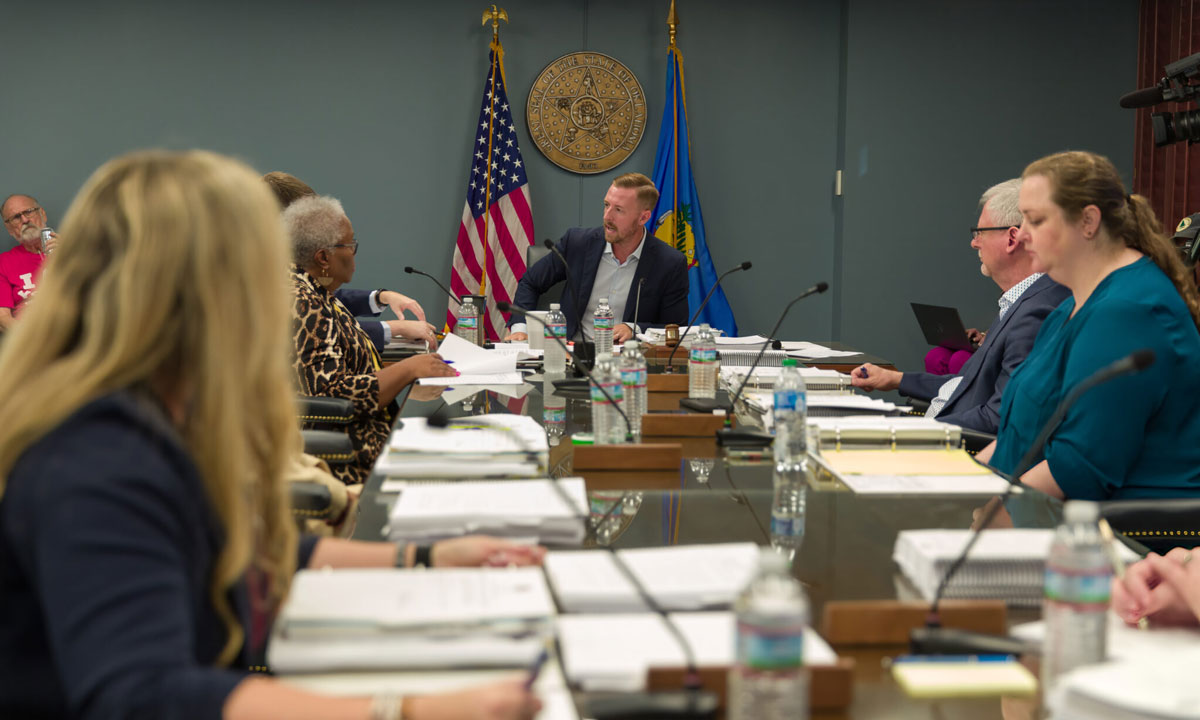Oklahoma Education Officials Urge Tulsa to Eye School Closures, Improve Scores
District leaders say any closures would be a local choice.

Get stories like this delivered straight to your inbox. Sign up for The 74 Newsletter
OKLAHOMA CITY — Tulsa Public Schools now faces the possibility of closing schools as the state adds new demands for academic improvement.
The Oklahoma State Board of Education created another set of goals for Tulsa to achieve by the end of the school year, and state Superintendent Ryan Walters said “all options are on the table” for penalties if the district falls short.
Walters and the board urged the school district to consider consolidating resources and funding into fewer school buildings, which means some sites could close.
“We think they need to be looking at school closures,” Walters said. “I’m not telling them which schools they need to close, but I am telling them when you look at these numbers of that many F schools, you look at the resources that you’re making available, you look at (the fact that) some of them have been on this (F) list for years, it absolutely has to be part of the decision-making process.”
Tulsa interim Superintendent Ebony Johnson said the district is exploring the possibility, as well as significant changes to staff.
“There will be district-office and school-level changes in personnel that will take place this school year,” Johnson told the state board. “We are also having conversations regarding ensuring that we provide the best quality learning experience for our students. And in that conversation, that could lend itself to some school closures.”
Such a move would not be unprecedented. Oklahoma City Public Schools closed 15 schools and reconfigured 17 others in 2019.
Rather than spreading students and resources across more schools with lower enrollment, the plan concentrated services, like counselors and academic programs, into fewer schools while cutting costs of building maintenance.
The threat of a state takeover has loomed over Tulsa for four months, as state officials continue to scrutinize the district’s poor academic output. Former Tulsa Superintendent Deborah Gist resigned in September to help stave off such a drastic measure from the state.
To avoid further penalties, Tulsa now must have 50% of its students score at least at a basic level on state reading tests this spring or see a 5% increase in academic growth in reading.
Academic growth measures students’ improvement over the previous year in a subject area. Scoring at a basic level on state tests indicates partial mastery of a subject.
Last school year, 57% of Tulsa district students scored below basic in reading, according to recently released state report cards.
Walters said he hopes to require all Oklahoma public schools to achieve at least 50% of students scoring at or above basic in reading and math. Adding this to every school’s yearly accreditation evaluation will require a 60-day period of public comment, state board approval and a review by the state Legislature — a process Walters said will begin in the coming weeks.
The state Board of Education also required Tulsa to improve its 18 schools that have been designated for “more rigorous intervention,” a label given to low-performing schools. Twelve of the 18 schools must show enough improvement that they aren’t marked for “more rigorous intervention” next year.
The district also must train all of its teachers in the science of reading.
Additionally, the board demanded the district’s finance team meet with staff from the Oklahoma State Department of Education to review district expenditures. The department’s general counsel, Bryan Cleveland, said Tulsa staff delayed the finance meeting multiple times.
However, email records show it was state agency staff who suggested postponing the meeting to after Thanksgiving because of the large volume of documents the state had asked the school district to compile, according to records the Tulsa district provided to Oklahoma Voice.
Cleveland questioned the thousands of dollars Tulsa spent on items listed as “miscellaneous” expenses. He said the district should explain these expenditures in greater detail.
“I’m not even saying these expenditures are necessarily bad,” Cleveland said. “The problem is you don’t know if they’re good or bad if you keep having different ways of using the word ‘miscellaneous.’”

Tulsa Board of Education President Stacey Woolley said she worries the new academic expectations won’t be attainable.
State officials complained the district’s academic plan wasn’t ambitious enough, but Woolley said Tulsa’s goals were developed with school data experts.
She said the possibility of closing schools will be a “very challenging conversation” for the Tulsa school board, but she didn’t dismiss the idea.
“What I’m certain of is our board wants to do what is best for students and that Dr. Johnson wants what is best for students,” Woolley said. “If she can tell us that she believes that her actions will help improve student outcomes, then that is critical for our students and we have as a board said that we will support her in doing what it takes to achieve outcomes.”
Any site closures would be a local decision made with input from families, the community and the Tulsa school board, district spokesperson Luke Chitwood said in a statement.
“Ultimately, the Tulsa Public Schools Board of Education considers any recommendation made and decides if any closures, consolidations, or changes in school format will be approved and implemented,” he said in a statement after the meeting.
Oklahoma Voice is part of States Newsroom, a nonprofit news network supported by grants and a coalition of donors as a 501c(3) public charity. Oklahoma Voice maintains editorial independence. Contact Editor Janelle Stecklein for questions: [email protected]. Follow Oklahoma Voice on Facebook and Twitter.
Get stories like these delivered straight to your inbox. Sign up for The 74 Newsletter

;)